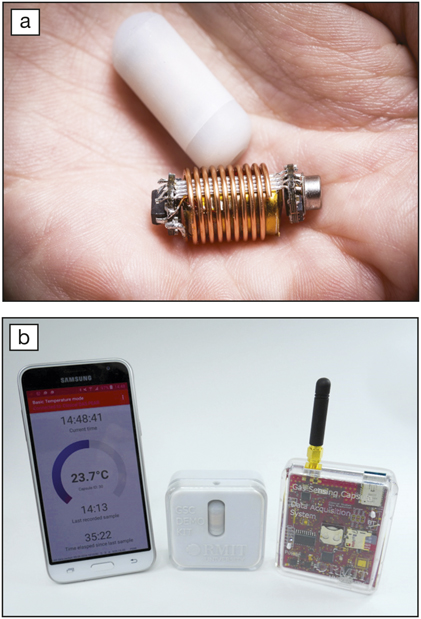A sci-fi concept of an ingestible capsule to monitor human health is becoming a reality with the first human pilot trials, as reported in a recent issue of Nature Electronics (doi:10.1038/s41928-017-0004-x). This milestone is a joint effort between teams of Australian researchers at RMIT University, Monash University, and CSIRO.
This research presents a turning point in the history of direct human health monitoring. The designed and tested ingestible capsule monitors oxygen (O2), hydrogen (H2), and carbon dioxide (CO2) gases in the gut. The inside of the capsule consists of thermal conducting and semiconducting sensors that detect these gases.
Kourosh Kalantar-Zadeh, distinguished professor at RMIT University and director of the Centre for Advanced Electronics and Sensors, who is a lead researcher in this study, says, “H2 appears in the pathway of most of the microbiome species of the gut.” The microbiome (around 1.5 kg) and the human body are in a symbiotic relationship. The health of a human gut heavily relies on the correct performance of the microbiome. Kalantar-Zadeh says, “Correct function means a healthy H2 profile.” The H2 profile changes in the range of detectability when the ecosystem of the microbiome changes, which makes it important to measure and monitor its profile in the gut. The O2 levels vary in each organ, so its measurement provides information about the location of the capsule in the body. Oxygen gas content variation and its relation to the presence in an organ was confirmed through an ultrasound imaging technique.
In order to create benchmark profiles, the fiber content in the diet was varied in the trials to identify the effects of different fiber diets on the gas profiles. With the intake of a high fiber diet, the capsule resided in the stomach, small intestine, and large bowels for 12, 7, and 4 hours, respectively. A low fiber diet could retain the capsule for a longer period and the capsule remained in the stomach, small intestinal transit, and large intestine for 13, 5.5, and 54 hours, respectively. On the fourth day of the trial, dietary fiber was introduced to help release the capsule. The researchers conducted these tests on four healthy volunteers. The gas profiles were successfully obtained while modulating gut microbial fermentative activities with different fiber content in their diets. Experiments were successful in evaluating the small and large intestinal transit times.

(a) Sensor-loaded capsule and the underlying sensor; (b) photo of the equipment including the phone app, capsule, and the data acquisition system. Credit: Prof. Kourosh Kalantar-Zadeh, RMIT University.
Christopher J. Bettinger of Carnegie Mellon University praises this study. “Real-time monitoring of biomarkers in the GI tract is an exciting prospect. In this work, the authors create an ingestible microelectronic sensor that can monitor dissolved gases in the GI tract. The authors use chemical signatures to understand the composition of the microbiome. This device could be useful in many applications related to metabolic health,” Bettinger says.


